Summer Breeding Season Calendar in Highvelds for Beef Cattle
Your Cattle Breeding Season
Should Only Last 42 Days!
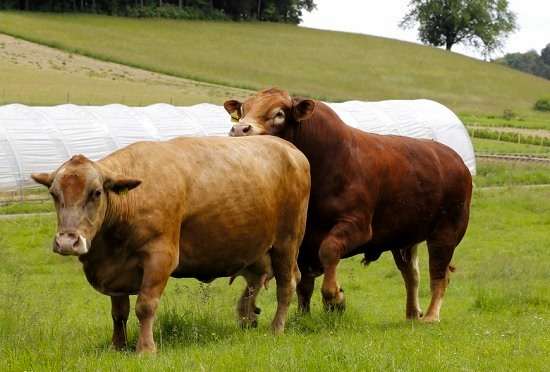
Image Credit:LID , Flickr, CC BY-SA 2.0
Shortening your cattle breeding season to 42 days is one of the biggest improvements you can make to your cow-calf beef production strategy.
Switching to a 42-day breeding season (the equivalent of 2 estrus cycles versus the 3 estrus cycles of a 60-day breeding season) has huge benefits. It will:
- simplify your herd management,
- improve your herd genetics,
- increase cow fertility during the breeding season,
- match your herd's nutritional demands to the grass available in your pastures,
- simple pasture preparation for winter grazing,
- and reduce the time it takes to grass-finish your calves before sale or slaughter.
(Disclosure: I get commissions for purchases made using Amazon links in my post.)
This article will focus on how a 42-day cattle breeding season improves your herd's nutrition and genetics. To learn about some of the other wide-ranging benefits of using a 42-day cattle breeding season, including its benefit to cattle health, cattle nutrition, calving management, and beef cattle fertility, I recommend reading the "The Cattle Year on Grass" chapter of my book Grass-fed Cattle #CommissionsEarned .
A 42-day breeding season makes it easier to manage your herd's nutrition requirements
By tightening the length of your cattle breeding season to 42-days, the nutritional requirements of each age group in your cattle herd will be much more closely matched to their peers.
Your oldest and your youngest calves will only be 6 weeks apart in age instead of 9 or more weeks, so their nutritional needs will be much more closely matched.
Likewise, a shorter breeding season also means that the nutritional requirements for pregnancy and lactation among your cows and heifers will be more closely synchronized.
With nutritional requirements being more streamlined it becomes much easier to monitor your cattle's body condition throughout the year and much simpler to provide the correct mineral, vitamin, and feed supplements when there's a nutritional shortfall.
A 42-day breeding season improves your herd genetics
A 42-day cattle breeding season ensures that only the most fertile and lowest-maintenance cows will rebreed and remain in your herd.
A big part of cow fertility depends on giving your cows sufficient time after calving to recover and prepare for breeding. It takes at least 2 full oestrus cycles before a cow's body fully recovers from her previous pregnancy.
In a 42-day cattle breeding season, every cow, including the last ones to calve, has time for at least 2 full oestrus cycles prior to being rebred. This ensures that every cow in the herd will be back up to her maximum fertility prior to being exposed to the bull herd. Consequently, any cow that fails to conceive during a 42-day breeding cycle clearly has lower beef cattle fertility and should be culled from your herd.
But when breeding cycles last 60 days (or longer), many low-fertility cows will manage to get pregnant on the third cycle, which perpetuates their poor quality genetics in your herd. Meanwhile, some good quality highly fertile cows that calved late in a 60-day calving season will fail to rebreed simply because they didn't have enough time to recuperate prior to breeding.
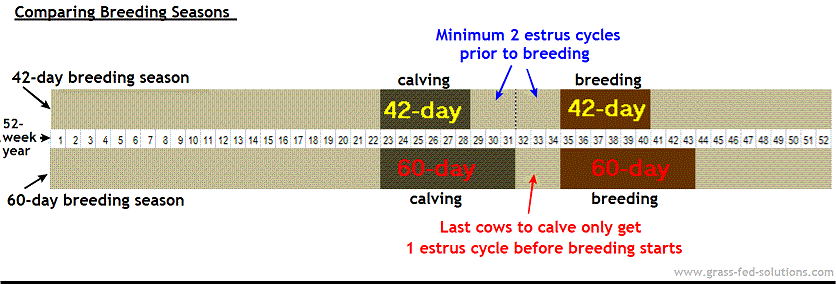
A 42-day breeding season favors the most efficient animals with the highest beef cattle fertility because all cows get a minimum of 2 estrus cycles to recover prior to the start of breeding season. By contrast, a 60-day cattle breeding season allows poorer quality, higher-maintenance genetics to contaminate your herd while putting good quality genetics at a disadvantage if they calved late in the prior calving season. (Click image to see a larger version)
A 42-day breeding season means that the most fertile good quality cattle have plenty of time after calving to prepare for breeding while the junk genetics of your poorest cattle are automatically culled from the herd because they don't get endless amount of time to conceive.
As I explain in my book Grass-fed Cattle, high beef cattle fertility and low-maintenance characteristics usually go hand-in-hand. High-strung, high-maintenance cows are often not very fertile, whereas the most efficient (low-maintenance) cows are often also the most fertile cattle in your herd.
Thus, a 42-day breeding cycle ensures that your herd is constantly favoring the genetic continuity of your most fertile, most efficient genetics. This in turn translates into higher conception rates, lower feed costs, and a lower cost of production.
A 42-day cattle breeding season is a key ingredient if you want to provide fresh pasture to your cows throughout their peak milk production period.
The chart below shows how the length of the calving season affects the age of the youngest calves at the end of the growing season in a summer calving program.
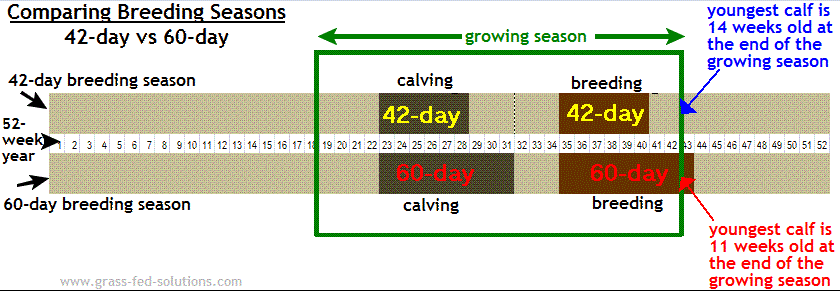
The youngest calves in a 42-day calving season will still have ample time to adjust to grazing before the growing season ends. But the youngest calves in a 60-day cattle breeding season will need to learn how to graze after the end of the growing season and their mothers will need to produce more milk after the end of the growing season. (Click image to see a larger version)
While farmers who calve earlier (before the beginning of the growing season) do not have this concern, the benefits of a summer calving program are so huge that you should seriously consider switching to a summer calving program combined with a 42-day calving season. You can learn more about the wide ranging benefits of summer calving in the article about how to choose the benefits of calving on pasture and how to choose the ideal calving date for raising cattle.
Summer calving combined with a 42-day calving season ensures that the last calves to be born will still be at least 3 months old before the growing season ends. Here's why that's important:
Calves don't start grazing in earnest until they reach approximately 3 months (12-weeks) of age. That is the age that their rumens start to work. From this point onwards they will start eating more grass than milk. The cow's milk production will gradually decline after their calves reach 3 months of age.
A 42-day cattle breeding season in a summer calving program thus ensures that the peak milk producing period happens while the cow is still grazing lush growing pasture. And, as the autumn pasture quality inevitably begins to decline, milk production naturally also declines with it, thus naturally reducing the cow's nutritional needs.
By contrast, in a 60+ day breeding season the youngest calves will still be needing tons of milk even as the fall pasture quality begins to decline, which means you either have to start providing nutritional supplements or switch to expensive stored feed in order to meet your cows' nutritional requirements. That increases your feed costs and raises your cost of production. Timing truly is everything.
This chart provides the perfect illustration of how a 42-day calving season combined with a summer grazing program creates the perfect match-up between cattle nutritional requirements and grass availability.
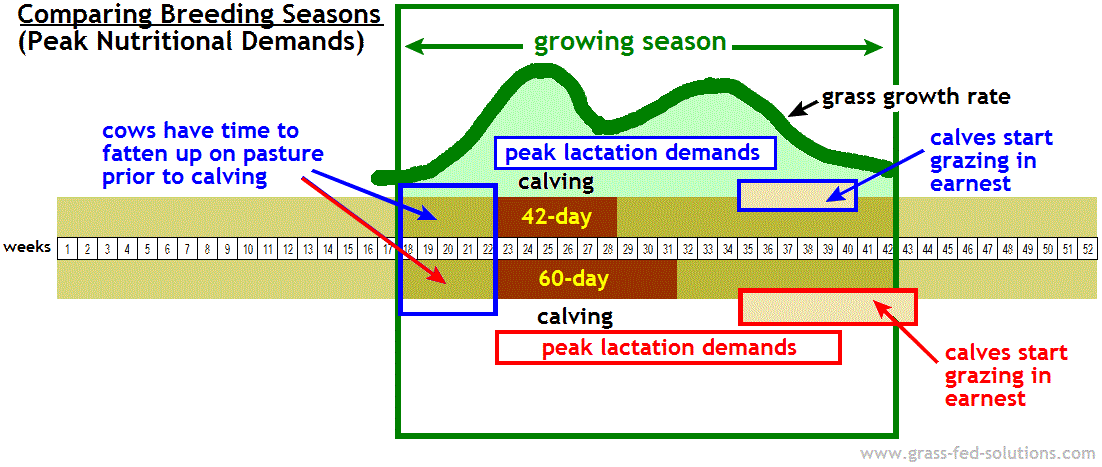
In a 42-day calving season, the nutritional demands of both cow and calf match the grass growth rates perfectly. A 60+ day cattle breeding season reduces grass demand during the peak growing season when there are grass surpluses, but increases grass demand in the fall when pasture availability is in decline. (Click image to see a larger version)
Cattle nutritional demands vary dramatically over the course of the year depending on what stage of pregnancy the cows are in, how much milk the cows are producing, and what age the calves are.
Grass is cheap compared to hay. And the cows harvest it themselves, for free.
So the number one way to reduce your feed costs and reduce your cost of production is to maximize how much of your cattle herds nutritional needs can be met by growing pasture. A summer calving season combined with a 42-day calving season truly creates the perfect nutritional match-up between pasture availability and the nutritional requirements of your cattle herd.
As the first green shoots kick off the start of the growing season, the cows have time to fatten up on grass prior to calving. This cheap growing grass is rich in vitamins and minerals so it supports the most important final months of the pregnancy, all without expensive stored feeds and minimal supplement costs for vitamin and minerals.
Then, as milk production kicks into action after calving and cows appetites soar to keep up, the massive amount of grass in the pastures is there to support the cows' needs.
By keeping the breeding season down to a trim 42 days, milk production (along with the cows' appetites) will naturally already be in decline long before the growing season ends. And the calves have a chance to break in their young rumens on fresh growing pasture instead of dry hay when they begin grazing in earnest at 3 months of age.
Breeding seasons that last any longer than 42 days will simply increase feed and supplementation costs because the peak nutritional requirements of your cattle herd spill outside the growing season.
A 42-day calving season makes it easier to fatten beef cattle for slaughter.
If you pick the right cattle breed for you beef program, you can calve in the summer, wean at the end of the winter, fatten the yearlings on cheap pasture the next summer and then slaughter the grass-finished calved as they come off pasture that autumn.
But timing is everything, and a 42-day breeding program is key to making all this happen without having to overwinter your grass-finished calves for a 2nd winter. Avoiding that 2nd winter is key to keeping your production costs low.
So here's a chart showing how calving season length affects the timing of your grass-finishing program:
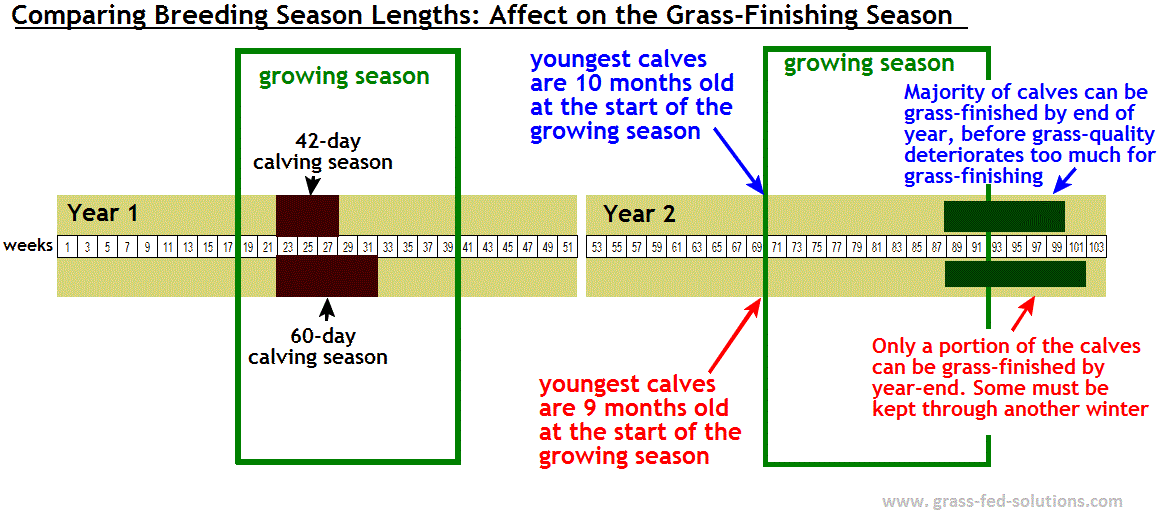
When using a 42-day calving season most of your calves can be grass-finished before their second winter (if you use an early-finishing breed and have good quality grass-finishing pastures to continue grass-finishing through the fall). But with a 60-day calving season many of the youngest yearlings will have insufficient time to fatten up before the end of fall and must be held over a second winter. (Click image to see a larger version)
Grass-finishing doesn't end on the day the pastures stop growing in the cold autumn weather. Your frost-killed pastures can continue to provide high quality forage suitable for grass finishing for many months after the growing season ends, but pasture quality does slowly begin to decline as fall turns into winter and as the snow begins to pile up in the pastures.
A 42-day calving season ensures that even the youngest calves can reach their target slaughter weights by late fall or early winter, before pasture quality declines too far.
But in a 60-day calving season, the youngest calves won't reach their ideal slaughter weights in time - once pasture quality drops off too much their weight gains will stall and they will either need to be fed expensive stored feeds to reach their target weights (i.e. put in a feedlot) or they will need to be overwintered on expensive stored feeds so they can be finished on pasture the next summer. Either scenario dramatically raises your cost of production.
Any time you can use your pastures instead of your hayshed to feed your cattle, you have a significant cost advantage over other farmers. A 42-day breeding program allows you to get the timing just right so that cheap pasture and the free grazing efforts of your cattle can provide the bulk of herd's forage requirements.
Thumbnail Image Credit:LID , Flickr, CC BY-SA 2.0
Related Articles:
(Disclosure: I get commissions for purchases made using Amazon links in my post.) And when you're ready to start planning your cattle farm, check out my book: Grass-Fed Cattle: How to Produce and Market Natural Beef.Use the links below to explore my book and read reviews on Amazon:
|
- Cattle Farming ›
- Cattle ›
- 42-Day Cattle Breeding
Source: https://www.grass-fed-solutions.com/42-day-cattle-breeding-season.html
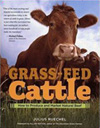

0 Response to "Summer Breeding Season Calendar in Highvelds for Beef Cattle"
Post a Comment